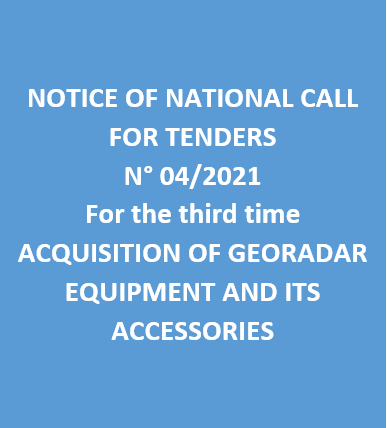| Annual program and technical progress report |
-

Activity Report 2023
-

Technical Program 2024
|
| Geocatalogue |

|
| Invitation to
tender |
-

REALIZATION OF THE TRAINING PLAN FOR THE YEAR 2022
-

ACQUISITION OF TWO SERVICE CARS
-

ACQUISITION OF GEORADAR EQUIPMENT AND ITS ACCESSORIES
|
|
Invest in Tunisia |

|
|
|
|
|
::
Documentation and Editions
>>
Research library
|
| |
|
[
Search by author
]
[
Search keyword
]
[
Search by index
]
[
Search by category
]
|
title of the reference :
|
Benthic foraminiferal assemblages between two major extinction events : The Paleocene El Kef section, Tunisia.
|
|
Publication Date:
|
1997
|
|
Author :
|
Kouwenhoven T.J., Speijer R.P., Van Oosterhout C.W.M, Van Der Zwaan G.J.
|
|
Catalogue type :
|
Livre
|
|
Catalogue reference :
|
T.29 Marine Micropaleontology T.29 Benthic foraminiferal assemblages between two major extinction events : The Paleocene El Kef section, Tunisia. The development of Benthic foraminiferal assemblages from the Paleocene outcrops of the El Haria Formation near El Kef, Tunisia is discussed qualitatively and quantitatively. The aim of the study is to reconstruct the paleoenvironmental evolution between the K/Pg boundary interval and the late Paleocene event, and to compare this evolution with results from other sites along the southern Tethyan margin. Eighty-four samples, covering virtually the entire Paleocene, provide a dataset that allows detailed qualitative and multivariate analysis.The benthic foraminiferal faunas indicate a complex pattern of environmental changes during the Paleocene, marked by the succession of different benthic associations. Following the K/Pg boundary event, community restoration was characterized by the gradual build-up of faunal diversity. Decreasing dominance and the entry of taxa common to normal marine, outer neritic to upper bathyal environment sindicate the completion of ecosystem restoration in Zone P1 b. A highly diverse benthic foraminiferal assemblage persisted throughout the remainder of the early Paleocene into the earliest late Paleocene. At the P3a-P3b zonal transition relative sea-level lowering is evidenced by the sudden disappearance or decreasing abundance of deeper-water taxa (e.g.Anomalinoides affinis, Gavelinella beccariiformis). Neritic deposition continued into Zone P4, when trophic levels at the seafloor incresed as indicated by the entry and increasing dominance of species such as Anomalinoides cf.aegyptiacus, Bulimina midwayensis and B. strobila which we consider to be sensitive to eutrophication. The combined effect of shallowing and the subsiquent eutrophication led to the estalishment of assemblages similar to late Paleocene benthic foramineferal assemblages from Egyptian sections, some of which record the latest Paleocene extinction event.These assembages were interpreted to be indicative of a middle neritic, highly eutrophic environment. Enhanced vertical fluxes of organic matter along the southern Tethyanmargin may have resulted from intensified upwelling.This eventually led to oxygen defiency at the seafloor. It appears that oxygen-deficient, high-productivity shelves were a common feature of the southern Tethyan margin during the latest Paleocene. bibliogr. benthos ; Foraminifera ; paléoécologie ; Paléocène ; Tunisie ; Tunisie nord Occidentale ; el Kef Speijer R.P. Van Oosterhout C.W.M Van Der Zwaan G.J. Kouwenhoven T.J. paleontologie
|
|
Indexation decimale :
|
paleontologie
|
|
Keywords :
|
benthos ; Foraminifera ; paléoécologie ; Paléocène ; Tunisie ; Tunisie nord Occidentale ; el Kef
|
|
Summary :
|
The development of Benthic foraminiferal assemblages from the Paleocene outcrops of the El Haria Formation near El Kef, Tunisia is discussed qualitatively and quantitatively. The aim of the study is to reconstruct the paleoenvironmental evolution between the K/Pg boundary interval and the late Paleocene event, and to compare this evolution with results from other sites along the southern Tethyan margin. Eighty-four samples, covering virtually the entire Paleocene, provide a dataset that allows detailed qualitative and multivariate analysis.The benthic foraminiferal faunas indicate a complex pattern of environmental changes during the Paleocene, marked by the succession of different benthic associations. Following the K/Pg boundary event, community restoration was characterized by the gradual build-up of faunal diversity. Decreasing dominance and the entry of taxa common to normal marine, outer neritic to upper bathyal environment sindicate the completion of ecosystem restoration in Zone P1 b. A highly diverse benthic foraminiferal assemblage persisted throughout the remainder of the early Paleocene into the earliest late Paleocene. At the P3a-P3b zonal transition relative sea-level lowering is evidenced by the sudden disappearance or decreasing abundance of deeper-water taxa (e.g.Anomalinoides affinis, Gavelinella beccariiformis). Neritic deposition continued into Zone P4, when trophic levels at the seafloor incresed as indicated by the entry and increasing dominance of species such as Anomalinoides cf.aegyptiacus, Bulimina midwayensis and B. strobila which we consider to be sensitive to eutrophication. The combined effect of shallowing and the subsiquent eutrophication led to the estalishment of assemblages similar to late Paleocene benthic foramineferal assemblages from Egyptian sections, some of which record the latest Paleocene extinction event.These assembages were interpreted to be indicative of a middle neritic, highly eutrophic environment. Enhanced vertical fluxes of organic matter along the southern Tethyanmargin may have resulted from intensified upwelling.This eventually led to oxygen defiency at the seafloor. It appears that oxygen-deficient, high-productivity shelves were a common feature of the southern Tethyan margin during the latest Paleocene.
|
|
Exemplaries :
|
TU1962
|
|
|
|
|
|
|
|



